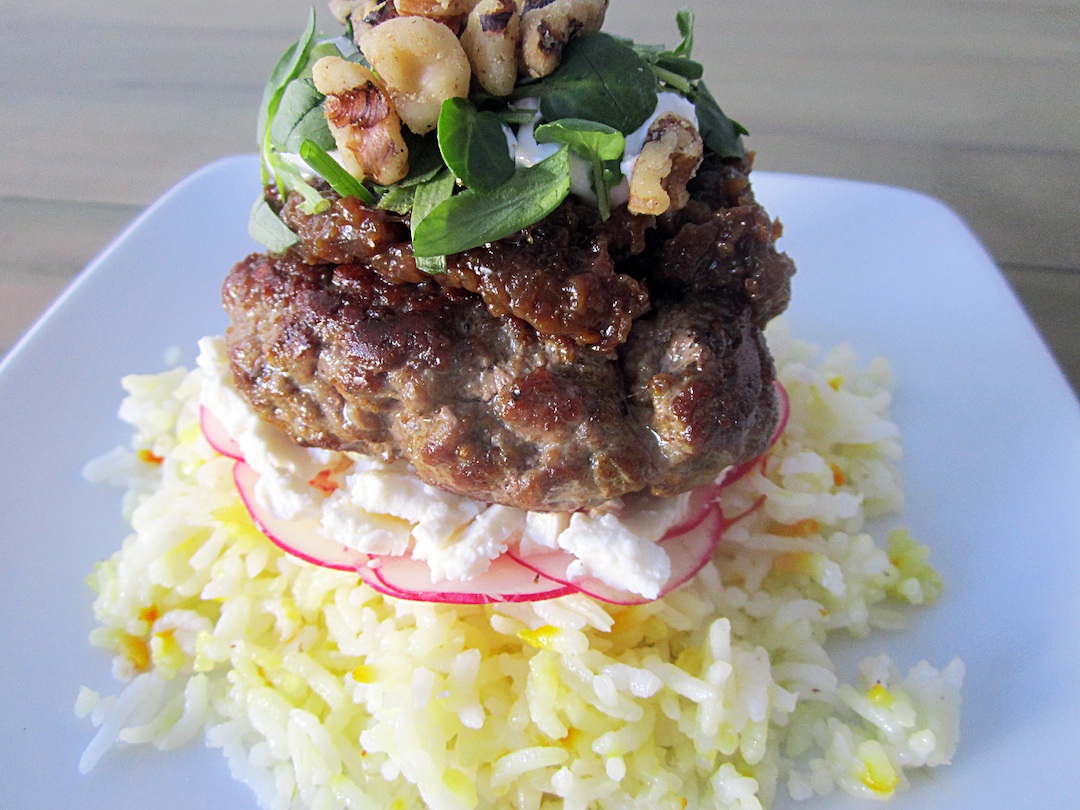 Persian Spiced Lamb Burgers with Saffron Rice and Fresh Herbs
Persian Spiced Lamb Burgers with Saffron Rice and Fresh Herbs
Apparently, were I Iranian, I would be doomed to be a spinster. Ok, probably not really in modern times, but there is a saying that a woman’s marriagability (I don’t think that’s really a word) is related to her ability to make rice. And when I say “make rice” I don’t mean plain old-fashioned steam it and serve, I mean Persian rice. I tried…epic fail! But I’ll get to the details in a minute, first let’s talk a little bit about Iran and then we can move on to the cooking and especially the rice.
The Islamic Republic of Iran is located in the Middle East and creates a sort of giant land bridge that separates the Caspian Sea and the Persian Golf – I imagine that no geologist would actually call it a bridge, but that’s kind of what it looks like to me.
It shares borders with Turkey, Iraq, Afghanistan, Pakistan, Azerbaijan, Armenia and Turkmenistan. At it’s height, the Persian Empire encompassed all of Iran and most of the surrounding land – today “Persian” and “Iranian” are used pretty much interchangeably in terms of cultural context, especially as we start talking about food.
And, although there is a great deal would could talk about beyond the food, Persian cuisine is rich in history and cultural influences and I have so much I want to tell you about the food, that I’m skipping right too it. Life is too short to spend too much time on politics, I’d rather go for the substance, or the sustenance, I’d rather have dinner 🙂
Persian cuisine and food culture is really cool and exotic and fascinating. Food plays an important part in the culture of Iran, it’s a food centric country. Hospitality is extremely important and food is a big part of that. You will always be offered food when visiting a traditional Iranian household. I read in one book that you should decline the food with thanks, it will be offered again, you should decline again, etc… until the ritual is done three times then the host will just serve anyway. As a guest you should thank and compliment profusely (I think that’s a good rule of thumb generally myself). The best foods are always served to guests (another good general rule), and guests should eat heartily but not be piggy and eat their hosts out of house and home (yet another good rule – liking the manners here).
Persian cuisine is a symphony of many spices (not hot chilies though), and a balance of sweet and sour. Fruits are commonly used in savory dishes and Persian cooks pride themselves on complex combinations of tastes that balance perfectly. Because Iran is so centrally located and Persia extended so far, many flavor traditions have passed back and forth, making Persian food also a balance of cultural influences. You see hints of India in the use of coriander, cardamom and cinnamon, you see hints of Greece in the stuffed grape leaves and use of yogurt. The tradition of marinated meat cooked on a skewer (kebab or shwarma) is a Persian method of cooking that is now common across the region and into the Mediterranean.
Iran produces lots of different fruits and vegetables – pomegranates, persimmons, melons, peaches, plums, dates, grapes, eggplant, squash, and cucumbers to name a few. They also grow almonds and pistachios and walnuts (English walnuts come from Iran) and produce one of the finest quality saffrons around (so I’ve read, I have not had the pleasure of side by side taste testing). Iran also produces caviar, sturgeon caviar, again said to be one of the finest in the world. All in all an embarrassment of riches from which to create a great burger – the hardest part was narrowing down the choices 🙂
So let’s get back to the rice. Ugh. Rice is an everyday staple of Persian cooking. But it isn’t as simple as that, they make rice differently than anyone I’ve encountered so far (or maybe I just didn’t read deeply enough before this). You don’t have to become an expert on Persian cuisine to realize that this rice is special and that Iranians are particular, everything I read about the food mentioned this. First, the rice is long grain – similar to basmati (in fact they import basmati from India to supplement local production). There are two basic ways to cook the rice. First is “chelo” (this is what I tried and failed to produce). In chelo, you parboil the rice then drain it and mound it into a pot with oil and a little bit of water. You steam it and somehow, magically you get a cooked rice with a crispy browned bottom. The bottom called “tah dig” is what everyone loves and is served separately. It is a practiced art to create tah dig and I frankly lost patience after three failed attempts. The best I got was a golden bottom that was unappetizingly crunchy (for my tastes), so I abandoned hope and just made rice.
You can also make kateh – which is rice more similar to the way we produce it here. Boil rice with butter or oil, salt and water, then simmer until the water is absorbed. The trick here though is that you also cook it for a while and get that crust that Persians love so much – you turn the pan over and cut the rice like a cake. No joy for me on this method either – I am truly hopeless.
Once you get good at making chelo and kateh, then you graduate to layered rice dishes – these are served for holidays and special occasions and are a real showpiece for the Persian cook. Needless to say, I didn’t even attempt them. When you have 193 recipes to create, you can’t spend months on one country, you’ll go crazy.
Another staple of the Persian table is “sabzi khordan” (spelling varies from one source to another), which is basically a bowl of herbs and veggies that is served with just about everything. The herb mixture varies and each cook/family has their own traditions, but I stuck with the herbs I saw most often referenced – mint, chives, tarragon, basil, watercress. You also see cilantro used a lot but since I’m not that big of a fan, I chose to leave it out, feel free to add some if you like that soapy flavor 🙂
Persians, like most foodie cultures it seems, have their own traditional spice mix. Theirs is called “advieh” and the recipes are myriad. The use of dried lime is pretty universal and gives a distinctive flavor to Persian food. You’ll see in Western style recipes that people substitute lime juice for dried lime – don’t do that, just go online and order some dried limes and you’ll understand why. Yes, they are tart, but there’s a concentrated lime peel flavor that mixes with the tart in a unique and interesting flavor – it’s tart without being bitter and intense without being overwhelming, with a little bit of fruit and earthiness that you just can’t get with any substitution.
The Persian table generally has radishes, something made from eggplant, stews, meats, yogurt, nuts, fruits…a little bit of everything. Again, my challenge was focus…where to start? I usually start with the meat, I find that gives me a frame on which to build the flavors of the dish. In this case I had to go with lamb. Not only is it a popular meat in Iran, but it also perfectly compliments the sweet and sour and the spice flavors that we’ve been talking about. Throw some advieh in to season the lamb and we’re set in the meat department.
I gave up on making tah dig and instead made a simple saffron steamed rice. I know it’s a cop out, but it was the best I could do and finish this project before I’m too senile to remember which country I’m on.
For toppings I really wanted to make a fruit/veg compote that would pay homage the stewing tradition and bring in some of the sweet and sour flavors in. So I put together a combination with eggplants and several native fruits along with pomegranate molasses to bring in the sour edge. Thinly sliced radish gave a nice crunch to the dish along with toasted walnuts (I’m amazed at how yummy nuts can be on a burger!). A yogurt sauce and some feta gave the dish added creaminess and a little salt kick. And lastly, to add color and brightness to the dish, some lovely fresh herbs ala sabzi khordan finished it off beautifully. It’s a lot of moving parts on this burger, but don’t get nervous. Nothing here is hard to make and almost all of it can be made ahead. If you slice the radishes ahead of time, just leave them soaking in ice water, it will keep them crisp and fresh. The only thing you don’t want to do too far ahead of time is the herb mix, basil will brown if it sits too long and the others will wilt, so chop these up last minute.
The final burger is unusual, the flavors are such a mixture of sweet, sour, creamy – it’s actually hard to describe. I know I get paid big bucks to describe food…oh, wait, I don’t get paid anything! Phew, now I don’t feel bad that I don’t have the words for this. You’ll just have to give it a whirl and let me know how you would describe it J
This is a hearty but not heavy burger that we served with a nice pinot noir (which is totally wrong based on the no alcohol rule of Iran, but I’m a rebel). If you want a more traditional drink, I’m told tea is the most popular beverage in Iran. Although one more note on that topic; pre-Muslim rule, Iran produced a fair amount of wine. They still grow grapes and use the grapes in cooking instead today – a bit of a waste of perfectly good grapes in my book, but to each his own.
If you like this burger you should try the Bahrain burger. It’s a lighter and slightly simpler burger, but has many of the same flavors of the region.
Iran Burger
1 pound ground lamb
1 ½ teaspoon advieh (recipe below)
½ teaspoon kosher salt
1 Tablespoon peanut oil
2 cups cooked rice (saffron in the cooking water is optional)
4-6 radishes sliced very thin
Crumbled feta cheese
Sweet and Sour Compote (recipe below)
Yoghurt Sauce (recipe below)
Fresh Herbs (recipe below)
4 Tablespoons toasted chopped walnuts
Mix the advieh, salt and lamb together and form into 4 patties. Heat the oil in a medium skillet, cook patties to desired temperature.
To serve scoop out ½ cup of rice on each plate. Add a layer of sliced radishes and generous helping of feta cheese, then the cooked patties. Put a big scoop of compote on top of the burger then add yoghurt sauce, fresh herbs and a Tablespoon of walnuts.
Advieh
1 teaspoon green cardamom seeds (crush about a Tablespoon of pods to get 1 teaspoon of seeds)
1 teaspoon coriander seeds
5 whole cloves
1 teaspoon turmeric
½ teaspoon ground cinnamon
1 teaspoon ground ginger
½ teaspoon cumin seed
½ teaspoon orange zest
1 dried lime crushed
Place all ingredients in a dry pan and warm over low heat until fragrant. Put the spices in a spice blender and pulse until everything is ground up.
Sweet and Sour Compote
1 Tablespoon peanut oil
1 cup cubed eggplant
1 cup chopped Turkish apricots
1 ½ teaspoons advieh
juice of 1 tangerine
2 Tablespoons black raisins
¼ cup pomegranate juice
2 Tablespoons pomegranate molasses
In medium saucepan, heat oil and brown eggplant for three minutes over medium heat. Add the rest of the ingredients and cook over low heat until syrupy. Cool slightly and pulse in a food processor until you get a basically even texture. Use slightly warm or room temperature.
Yoghurt Sauce
1 cup Greek yoghurt (2% fat)
1 teaspoons minced shallots
1 Tablespoon chopped fresh mint
salt to taste
Add all ingredients in a glass bowl and refrigerate until ready to use.
Fresh Herbs
¼ cup fresh mint chopped
¼ cup fresh chives chopped
¼ cup fresh tarragon chopped
½ cup fresh watercress chopped
2 Tablespoons fresh basil chopped
Combine all ingredients and serve.
©Copyright 2013 Linda Monach

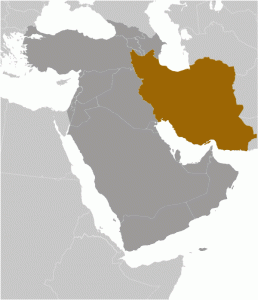
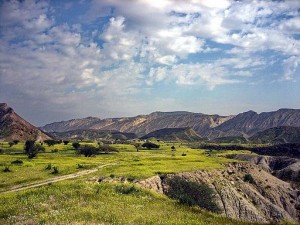
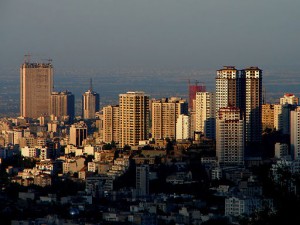
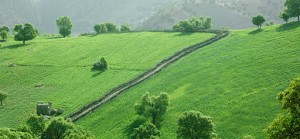
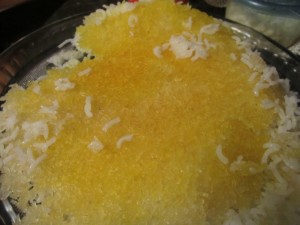
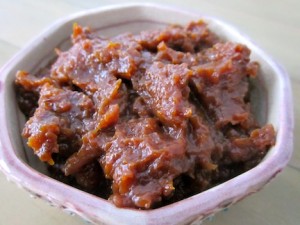
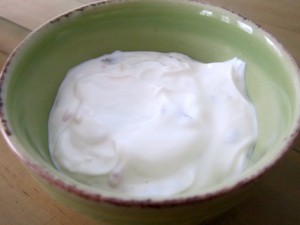


I made these last night, following the recipe exactly. These are AMAZING! There was a delightful amalgamation of flavours that complemented each other beautifully. Thank you for sharing this recipe.
So happy you enjoyed them! What country are you trying next? 🙂